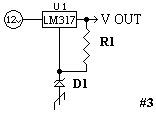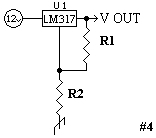![]() WARNING! The circuitry described herein if for cordless phones
that use a "wall-wart" not 120volt AC line powered
devices. Please use a little common sense, and if in doubt do not
do it. I take no responsibility for any death, damages, or injury
incurred by anyone. If you are not familiar with electronics,
are uncertain of safe operating practices or are lacking in
common sense, please leave now!
WARNING! The circuitry described herein if for cordless phones
that use a "wall-wart" not 120volt AC line powered
devices. Please use a little common sense, and if in doubt do not
do it. I take no responsibility for any death, damages, or injury
incurred by anyone. If you are not familiar with electronics,
are uncertain of safe operating practices or are lacking in
common sense, please leave now!
Most hams have a 12 volt backup system in the hamshack, so that we can continue to operate during a power outage ( as is often the case during severe weather ). It is also safer to operate from a DC supply during electrical storms (reducing the possibility of lightning running in on the AC supply and damaging the equipment or worse, the operator). This in combination with an attic mounted antenna is (or should be) a part of every hamshack. Why then should we be tied to a line connected phone, or a cordless phone that is subject to be inoperable during power outages, or loose the connection anytime the power blinks? But few cordless phones are designed to operate from 12 volts DC.
The simple circuit shown below is my answer to this, it
regulates the 12 - 14 volts from the hamshacks DC system to a
voltage suitable for the cordless phone. First check the rating
and be sure that it is DC, most will have the operating voltage
stamped on them. But if not it is a simple matter to push a pin
through the insulation of each wire and connect a voltmeter to
measure the voltage under operating conditions (place a call and
watch the meter). Then select the version of the circuit that
will best suit your needs, construction is not critical, point to
point wiring, perfboard, or general purpose pc board (RS #276-148a)
may be used. Bring a small zip-cord from the output to the power
connector on the phone (either purchase a connector to fit or cut
the wire from the wall-wart), and another piece of zip-cord from
the shack's battery to the input, connect the negative wire from
the battery and the negative to the phone, to the ground point of
the circuit. insulate everything (including the mounting tab of
the regulator) by covering with heatshrink tubing, and connect it
all up. You may want to include a capacitor connected from the
input to ground and another from the output terminal to ground to
improve transient response and to help keep RF out of the supply,
![]() .1
�f monolithic or tantalum works well for this
application.
.1
�f monolithic or tantalum works well for this
application.
 |
#1 The simplest method. For U1 use 7805 for 5 Volts, 7806 for 6 Volts, 7808 for 8 Volts. |
 |
#2 Uses a Diode to up the output. R1 = 1k, For D1 almost any diode (1N914, 1N4001 etc.). Or try an led for D1 to get another volt or so and a power on indicator light. [ V out = regulator voltage + diode forward voltage ] |
 |
#3 Uses a zener diode for D1 a 1N4739(9.1volt) and for R1 100 ohms should do, output will be about 10.3 volts. Select a zener voltage that is about 1.25 volts below the requirements of the phone. [ V out = zener voltage + 1.25 volts ] |
 |
#4 With R1=150 ohms: R2=1k trim pot (RS #271-280) gives adjustable output from 1.25 to 9.6 volts, or by adding a 150 ohm resistor in series with the trim pot gives 2.5 to 10.8 volts. or to use a fixed resistor for R2 use the formula [ V out = 1.25*(1+R2/R1) ] or see table below. |
| R1=100 | R1=120 | R1=150 | R1=220 | R1=240 | ||
| R2=ohms | Vout= | Vout= | Vout= | Vout= | Vout= | |
| 0 | 1.25 | 1.25 | 1.25 | 1.25 | 1.25 | |
| 100 | 2.5 | 2.29 | 2.08 | 1.82 | 1.77 | |
| 120 | 2.75 | 2.5 | 2.25 | 1.93 | 1.875 | |
| 150 | 3.125 | 2.81 | 2.5 | 2.1 | 2 | |
| 220 | 4.0 | 3.54 | 3.08 | 2.5 | 2.4 | |
| 240 | 4.25 | 3.75 | 3.25 | 2.6 | 2.5 | |
| 270 | 4.625 | 4.06 | 3.5 | 2.78 | 2.6 | |
| 330 | 5.375 | 4.69 | 4.0 | 3.125 | 2.97 | |
| 470 | 7.125 | 6.15 | 5.16 | 3.92 | 3.7 | |
| 560 | 8.25 | 7.08 | 5.92 | 4.49 | 4.17 | |
| 680 | 9.75 | 8.33 | 6.92 | 5.1 | 4.79 | |
| 820 | 11.5 | 9.79 | 8.08 | 5.9 | 5.52 | |
| 1K | 13.31 | 11.66 | 9.58 | 6.93 | 6.46 | |
| 1.2K | 16.25 | 13.75 | 11.25 | 8.07 | 7.5 | |
| 1.5K | 20 | 16.875 | 13.75 | 9.77 | 9.06 | |
| 2.2K | 28.75 | 24.16 | 19.58 | 13.75 | 12.7 | |